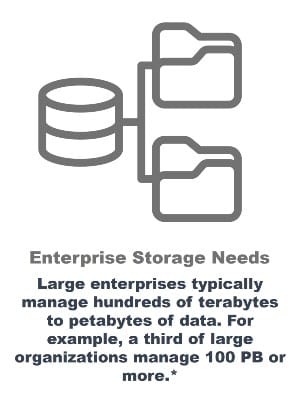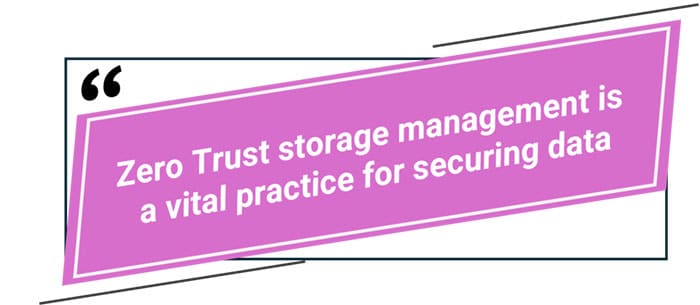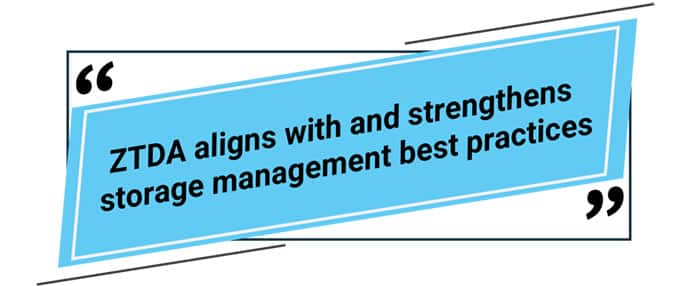
Modern zero trust storage management improves data security by enforcing file-level access controls, eliminating blind spots, and enabling compliance without relocating data. This blog explores 8 reasons why your organization should upgrade to a zero trust approach.
8 Benefits of Zero Trust Storage Management
Estimated reading time: 5 minutes
Table of Contents
Introduction: Why Zero Trust Storage Management Matters

Zero Trust Data Access (ZTDA) offers a transformative approach to storage management, redefining how organizations secure and govern their data. By integrating ZTDA principles with storage management, businesses can achieve enhanced security, operational efficiency, and compliance while fostering collaboration and scalability.
This article explores the Top 8 Reasons for Zero Trust Storage Management and delves into the foundational importance of storage management itself. From security and compliance to operational excellence and risk mitigation, we’ll outline why a Zero Trust approach is not just a best practice but a necessity for modern enterprises.

Why is Storage Management Important?
Storage management is a critical aspect of enterprise data governance, security, and operational efficiency. Here’s why it matters:
-
Security and Data Protection
-
-
- Preventing Unauthorized Access: Controlling who can access which storage repositories ensures that sensitive data is only available to authorized users. This reduces the risk of data breaches and unauthorized sharing.
- Granular Permissions: Assigning specific permission levels (read-only, edit, delete) for each user ensures the principle of least privilege is enforced, minimizing exposure to human error or malicious intent.
-
-
Compliance and Legal Requirements
-
-
- Many industries must comply with regulations such as GDPR, HIPAA, or CCPA, which often mandate strict controls over data access and audit trails.
- Proper storage management ensures that sensitive information (e.g., personal data or financial records) is only accessible to those with a legitimate need, helping organizations remain compliant.
-
-
Operational Efficiency
-
-
- Streamlined Workflows: Ensuring employees have access only to the resources they need prevents bottlenecks in productivity while reducing clutter from irrelevant data.
- Efficient Resource Allocation: Proper management allows IT administrators to optimize storage resources, avoiding waste and ensuring high-priority systems have the capacity they need.
-
-
Enhanced Collaboration
-
-
- By clearly defining and managing permissions, organizations can enable secure collaboration across teams, departments, and even external partners without risking data leakage.
- For example, contractors might be given temporary, limited access to certain repositories for the duration of their projects.
-
-
Risk Mitigation
-
-
- Data Loss Prevention: By controlling who can modify or delete files, organizations can reduce the risk of accidental or intentional data loss.
- Audit Trails and Forensics: Well-implemented access controls and logs make it easier to track and investigate incidents, ensuring accountability.
-
-
Scalability and Future-Proofing
-
-
- As businesses grow, the complexity of managing data across multiple repositories increases. A robust storage management system supports scalability, allowing organizations to efficiently onboard new users, integrate new storage systems, and handle larger volumes of data.
-
Best Practices for Storage Management
- Role-Based Access Control (RBAC): Assign permissions based on user roles rather than individual users to streamline management.
- Regular Audits: Periodically review access logs and permissions to ensure they align with current organizational needs.
- Integration with Zero Trust Principles: Incorporate zero trust data access solutions to enforce continuous authentication and verification.
- User Training: Educate employees on best practices for handling data securely and responsibly.

8 Benefits of Zero Trust Storage Management Best Practices
Zero Trust Data Access (ZTDA) is a critical framework for enhancing storage management. It operates on the principle of “never trust, always verify,” ensuring that access to storage resources is continuously validated based on strict identity, context, and policy requirements. Here’s how ZTDA aligns with and strengthens storage management best practices:
-
Enforces the Principle of Least Privilege
-
-
- ZTDA ensures users are granted access only to the specific storage repositories and data they need to perform their tasks, and nothing more.
- Fine-grained control at the user and device level minimizes risk by limiting exposure to sensitive data.
-
-
Applies User Verification
-
-
- ZTDA implements user verification. This mitigates risks associated with session hijacking or credential compromise.
- In storage management, this means users are continuously monitored for compliance with security policies, even after access is granted.
-
-
Mitigates Insider Threats
-
-
- Internal users with malicious intent or those making unintentional errors pose significant risks to storage repositories.
- ZTDA incorporates bandwidth monitoring to detect unusual activities, such as bulk data downloads or access to unauthorized storage areas, to alert administrators and revoke permissions as appropriate.
-
-
Supports Regulatory Compliance
-
-
- Many data protection regulations (e.g., GDPR, HIPAA, and CCPA) require organizations to demonstrate secure data access and control over sensitive information.
- ZTDA ensures access policies are enforced consistently across all storage environments, providing a comprehensive audit trail for compliance verification.
-
-
Provides Seamless Multi-Repository Management
-
-
- Modern enterprises often use diverse storage solutions, including on-premises servers, cloud platforms, and hybrid environments. ZTDA enables centralized policy enforcement and visibility across all these repositories.
- This unified approach reduces complexity while enhancing security and operational efficiency.
-
-
Delivers Zero Trust Integration with Data Access Logs
-
-
- ZTDA enhances visibility by maintaining detailed logs of who accessed what and when. These logs are crucial for storage management audits and forensic investigations.
- They also empower administrators to detect and respond to potential misconfigurations or access anomalies.
-
-
Brings Scalability for Growing Data Ecosystems
-
-
- As organizations grow, the complexity of managing storage access increases. ZTDA’s role-based policy enforcement scales efficiently, reducing the administrative burden of manually updating permissions for new users, devices, or storage systems.
-
-
Enhances Collaboration Without Compromising Security
-
-
- By enabling secure, conditional access to specific data repositories, ZTDA supports collaboration between internal teams, contractors, and third parties while maintaining strict data protection standards.
- For instance, contractors might only be allowed access to designated project files, with permissions automatically expiring after the project ends.
-
| Feature | Traditional Storage Security | Zero Trust Storage Management |
| Trust Model | Implicit (internal = trusted) | Explicit (trust no one by default) |
| Access Control | Broad access permissions | Granular, file-level access |
| Authentication | One-time login | Continuous verification |
| Monitoring & Logging | Limited audit trails | Full visibility into every interaction |
| Data Movement | Often centralized in cloud | Data stays in place |
| Insider Threat Protection | Weak due to broad trust zones | Strong via least privilege enforcement |
| Compliance Readiness | Complex and manual | Built-in and automated |
Conclusion: Embracing Zero Trust for Modern Storage Management
Effective storage management is no longer a luxury—it’s a necessity in a world where data breaches, regulatory compliance, and operational demands are ever-evolving challenges. By adopting a Zero Trust Data Access (ZTDA) framework, organizations can transform their approach to managing storage repositories, ensuring security, efficiency, and scalability across diverse environments.
ZTDA not only reinforces the principle of least privilege and user verification but also addresses insider threats, supports compliance, and fosters seamless collaboration without compromising security. It offers a proactive, dynamic solution to the complexities of modern storage ecosystems, enabling businesses to stay ahead of threats while maintaining operational excellence.
As your organization grows, so does the importance of scalable, secure, and adaptable storage management practices. By integrating Zero Trust principles into your strategy, you’re not just protecting your data—you’re future-proofing your enterprise against the challenges of tomorrow. Embrace Zero Trust Storage Management today to safeguard your most valuable asset: your data.
For related articles see Why Zero Trust Data Access User Management is Crucial for IT, Top 8 Reasons Your Organization Needs Zero Trust Activity Tracking and Embracing Zero Trust Data Access for IT-Controlled Chain-of-Command.
Learn More About FileFlex Sign Up for a Free TrialFrequently Asked Questions
What is zero trust file sharing management?
Zero trust file sharing management applies continuous verification, least-privilege access, and strict data governance to every file-sharing interaction—ensuring only verified users and devices can access or share sensitive data.
What are the benefits of zero trust file sharing management?
Key benefits include enhanced data protection, prevention of insider threats, full auditability, and compliance with regulations like HIPAA, GDPR, and CCPA—all without requiring a VPN or centralized cloud repository.
How is this different from traditional file sharing tools?
Traditional tools focus on perimeter security and broad user access. Zero trust file sharing restricts access to only those who are continuously verified and authorized, reducing data leakage and lateral movement risk.
How does FileFlex support zero trust file sharing?
FileFlex enforces Zero Trust Data Access (ZTDA) by verifying identity, applying file-level access controls, logging all activity, and keeping data in place—making it a secure platform for compliant file sharing and collaboration.